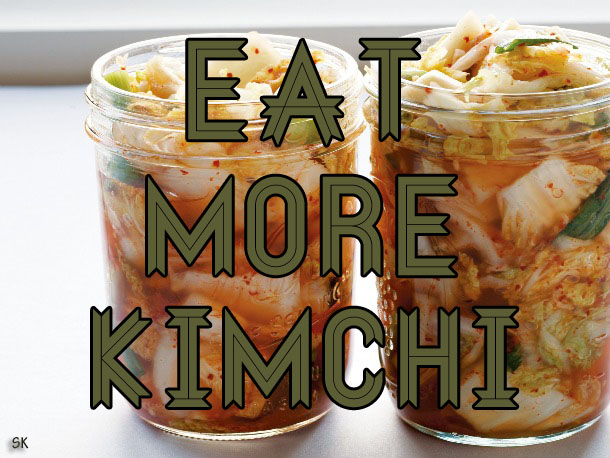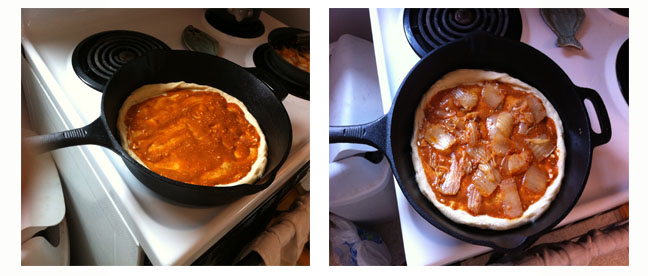By Shannon Kuhn
“I lay the curious piece of flat lettuce on the palm of my hand, adding the steaming bulgogi beef, kimchi, and spicy sauce as directed. I fold it into a little package, as if I was going to mail it somewhere, but instead I insert it into my mouth. The meat is tender and the kimchi has a kick to it. I swallow and reach for more. We are in Busan, South Korea, sitting in a circle, cross-legged on mats. There is a large burner in the center of the table, surrounded by a sea of small white porcelain dishes containing a multitude of side dishes. Here there is no such thing as ordering for one. On the contrary, restaurants usually serve a meal in groups of four, and everyone shares. You do not eat alone; you eat with your family, your friends, your co-workers. Meals are a time of intimacy, it is not possible to dine alone or to simply scarf your food down and leave. To eat is to be with family.” – Shannon Kuhn, Korea, 2009
Korean food, and Kimchi, is one of the world’s best-kept secrets. It is a delicious and healthy cuisine to eat traditionally, but also one of the bests to be creative and have fun with. Alaska doesn’t really have a a thriving Korean food scene yet, but it’s my hope that one day soon it will be a common option when going out for dinner, as well as cooking at home.
Kimchi is the national dish of Korea. It is a super-spicy fermented cabbage condiment (think Sauerkraut marinated in hot sauce!) that is served at every meal. Kimchi is a staple of the high-fiber, low-fat cultural diet that has kept obesity at bay in Korea. Kimchi is used in everything from soups to sandwiches, and as a topping on pizza and burgers. Alaskan-made Kimchi is truly spectacular, as our homegrown cabbage is sweet and crunchy, perfect for pickling and fermentation. It makes my mouth water to think about harvesting this fall and making enough kimchi to last through the winter. However, you can make kimchi with any vegetable, or even fruit if you are feeling adventurous! It really is a super-food, and pretty much great on anything.
Why to try it: Kimchi is loaded with vitamins A, B, and C, high in fiber, and an excellent antioxidant. It’s biggest benefit may be in its “healthy bacteria” called lactobacilli, found in fermented foods like kimchi and yogurt.
Here are recipes for adding kimchi into your diet! Bacon Kimchi pizza and Beet Kimchi recipes below, but also try putting kimchi in your quesadilla, grilled cheese, burrito, or reindeer sausage! YUM.
Bacon Kimchi Pizza
Makes one 10 inch pizzaIngredients:
- About 1/2 pound of pizza dough (you can order to go at Bear/Moose’s Tooth)
- 1 cup kimchi
- 3 cloves of garlic, sliced
- 3 strips of bacon (and fat!)
- 1 teaspoon of Worcestershire sauce
- 2 tablespoons of Hoisin sauce
- 1 teaspoon of Sriracha sauce
- 1 teaspoon of mayonnaise
- 2 cups of shredded mozzarella cheese
- 2 stalks of scallion
- 2 teaspoons of olive oil
*If you have leftovers, try putting a fried egg on top of your pizza for breakfast!
1. In a pan over high heat. Place bacon on the pan and cook until crispy on both sides, about 6-7 minutes. Transfer bacon pieces to a plate. With the fat that is already on the pan, turn the heat to high. Add kimchi, with garlic and cook. Continue to stir and cook until there is no more moisture left in the pan. Once the kimchi and garlic both turn slightly brown, remove from heat.
2. Place flour on your surface and rolling pin. Roll out the dough slowly into a circle. Take the dough in your hands and stretch them out as evenly as possible. Continue rolling until the dough forms a circle.
3. In a small bowl, mix Worcestershire sauce, Hoisin sauce, Sriracha sauce (optional), and mayonnaise. Adjust seasonings to your liking. Set aside.
4. Place pizza dough directly on the cookie sheet or cast iron skillet. Spread 1 teaspoon of olive oil on the dough. Add sauce, leaving a little bit of space on the edges. Add kimchi. Use kitchen scissors to cut scallions and bacon right onto the pizza. Finish with cheese.
5. Place pizza in the middle rack of the oven and cook for 7 minutes, or until the cheese has melted and the dough has a crispy brown color.
Ingredients:
- 1 head of cabbage
- plenty of salt
- 2 beets, grated
- 2 red onions, chopped
- 2 – 3 cloves of garlic, crushed
- slice of ginger, about 1 cm thick, crushed
- 2 teaspoons hot chili powder (or to taste)
- 4 teaspoons sugar
1. Rinse and chop the cabbage (into long strips or squares, whatever you prefer).
2. Layer the cabbage in a tupperware or plastic bag, and sprinkle salt liberally in between each layer, rubbing salt into cabbage.
3. Let sit for at least 6 hours or overnight.
4. The salt releases the water in the cabbage, so drain any excess water.
5. Add your grated beets, red onions, garlic, ginger, chili, and sugar.
6. Mix everything thoroughly with your hands for a couple of minutes.
7. Put in a jar with a tightly sealed lid and let the fermentation begin! Allow to sit for a few days in the fridge for best results.
The Anchorage Food Mosaic’s mission is to build and celebrate community through our cultural foods.
In our current conventional agricultural system, a monoculture replaces lots of genetically diverse plants with one uniform crop, which is highly susceptible to disease and failure. In the same way that monocropping is dangerous to the future of a crop; we must encourage diversity within our community to prevent disease.
In order for our community to thrive we need to embrace and nurture the “mosaic” of people in this city.
The Anchorage Food Mosaic features different community members through photos and traditional recipes. Let us cook each others cultural foods and share our stories with one another.







